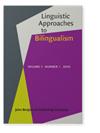Mixing adjectives
IF 1.8
2区 文学
0 LANGUAGE & LINGUISTICS
引用次数: 0
Abstract
How do bilinguals mix adjectives and nouns from two languages with a word order conflict at the boundary between them? Prominently competing theories of code-switching (CS) that appeal to abstract features or to a matrix language remain in a stalemate, since their predictions have been reported to mostly coincide. Here, we contribute data from northern New Mexico bilingual community members who switch between Spanish and English in both directions. Beyond the NP-internal mixes within the purview of the theories, the widened data set encompasses all relevant mixes and positions: every adjective or associated noun at the boundary with the other language. We thus assess lone-item and multi-word mixing types, distinguishing also between multi-word CS at different points of the NP. Multi-word CS at the adjective-noun boundary is indeed rare. These bilinguals choose CS after the determiner with prenominal modifiers in English adjective-noun pairs, as previously observed, and at the external NP boundary. Furthermore, they disproportionately prefer the shared predicative position. Accounting for all adjective mixes, the Variable Equivalence hypothesis proposes that, where cross-language equivalence is not consistent due to language-internal variability, bilinguals prefer CS at alternative syntactic boundaries that are consistently equivalent and more frequent in their combined linguistic experience.混合的形容词
双语者如何将两种语言的形容词和名词混合在一起,并在它们之间的边界处产生语序冲突?吸引抽象特征或矩阵语言的代码转换(CS)理论仍处于僵局,因为据报道,它们的预测大多一致。在这里,我们提供了新墨西哥州北部双语社区成员的数据,他们在西班牙语和英语之间双向切换。除了理论范围内的NP内部混合之外,扩大的数据集还包括所有相关的混合和位置:与其他语言边界上的每个形容词或相关名词。因此,我们评估了单项和多词混合类型,并区分了NP不同点的多词CS。形容词-名词边界的多词CS确实很少见。正如先前所观察到的,这些双语者在英语形容词-名词对中,在具有前名修饰语的限定词之后,以及在外部NP边界处选择CS。此外,他们更喜欢共同的表语位置。考虑到所有形容词的混合,可变等价假说提出,当跨语言等价由于语言内部的可变性而不一致时,双语者更喜欢在其他句法边界上的CS,这些句法边界是一致等价的,并且在他们的综合语言体验中更频繁。
本文章由计算机程序翻译,如有差异,请以英文原文为准。
求助全文
约1分钟内获得全文
求助全文
来源期刊

Linguistic Approaches To Bilingualism
Social Sciences-Linguistics and Language
CiteScore
3.20
自引率
9.10%
发文量
24
期刊介绍:
LAB provides an outlet for cutting-edge, contemporary studies on bilingualism. LAB assumes a broad definition of bilingualism, including: adult L2 acquisition, simultaneous child bilingualism, child L2 acquisition, adult heritage speaker competence, L1 attrition in L2/Ln environments, and adult L3/Ln acquisition. LAB solicits high quality articles of original research assuming any cognitive science approach to understanding the mental representation of bilingual language competence and performance, including cognitive linguistics, emergentism/connectionism, generative theories, psycholinguistic and processing accounts, and covering typical and atypical populations.
 求助内容:
求助内容: 应助结果提醒方式:
应助结果提醒方式:


